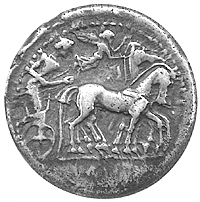 The Iliad and Odyssey of Homer mix
methods of warfare. Many scenes hark back to
the age of heroes, of Mycenaean kings and
warriors who fought man to man often after
arriving at the site by chariot. Close reading
reveals as many references to warfare of the 8th
century BC, when the Hellenic city states were
rising from a Dark Age and fought each other
during periods of intense rivalry. For it was in
the 8th century (the 700's BC) that the Homeric
poems were finally written down.
The Iliad and Odyssey of Homer mix
methods of warfare. Many scenes hark back to
the age of heroes, of Mycenaean kings and
warriors who fought man to man often after
arriving at the site by chariot. Close reading
reveals as many references to warfare of the 8th
century BC, when the Hellenic city states were
rising from a Dark Age and fought each other
during periods of intense rivalry. For it was in
the 8th century (the 700's BC) that the Homeric
poems were finally written down.
Warfare of the 8th century and for the next several centuries was not that of individual champions but of formed bodies of middle-class farmers fighting in close ranks. Unlike the "flower of chivalry" that fought the English at Agincourt or the "scum of the earth" led by Wellington in the Iberian Peninsula, the armies of the Hellenic city states were made up of well-off citizenry able to afford heavy armor but not expensive horses.
Though they drilled regularly, and in their youth may have spent several years in full-time training, they were essentially amateurs. Men who put down their tools, gathered up their weapons and answered their city's call to stand in the packed ranks to defend their heritage and lands.
But did they yet fight as hoplites in the phalanx? When and why did their peculiar form of warfare come into being?
Hoplites vs. Phalanx
Back to Table of Contents -- Against the Odds vol. 1 no. 1
Back to Against the Odds List of Issues
Back to MagWeb Magazine List
© Copyright 2002 by LPS.
This article appears in MagWeb.com (Magazine Web) on the Internet World Wide Web.
Other military history articles and gaming articles are available at http://www.magweb.com
* Buy this back issue or subscribe to Against the Odds direct from LPS.
